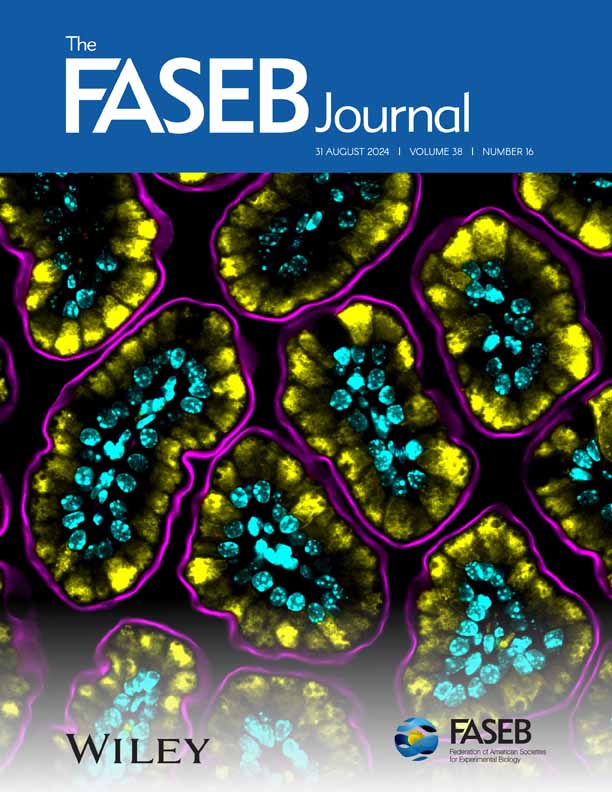心肌梗死后代谢重编程介导巨噬细胞极化
IF 4.4
2区 生物学
Q2 BIOCHEMISTRY & MOLECULAR BIOLOGY
引用次数: 0
摘要
巨噬细胞在心肌梗死(MI)后介导炎症和心脏重塑中发挥关键作用。糖酵解和氧化磷酸化(OXPHOS)之间的代谢转换与巨噬细胞向促炎(M1)和抗炎(M2)表型的极化有关。M1巨噬细胞依赖糖酵解,M2巨噬细胞依赖OXPHOS。然而,代谢在心肌梗死后巨噬细胞极化中的作用尚不清楚。因此,我们假设心肌梗死后抑制糖酵解会促进巨噬细胞极化至抗炎M2表型,并改善心肌梗死后的预后。对成年雄性C57BL/6J小鼠进行左前冠状动脉永久性结扎1、3、7天诱导心肌梗死。为了直接评估心肌梗死后巨噬细胞糖酵解和OXPHOS,从梗死区(D1和D3组n=3)或健康对照心脏(第0天或第0天;n=3)通过免疫磁分离或从腹腔冲洗,并进行海马分析,以确定细胞外酸化率(ECAR)和耗氧量(OCR)。为了评估巨噬细胞代谢的作用,另一组小鼠在心肌梗死后的前3天给予富马酸二甲酯(DMF, 15mg/kg I.P.)或对照溶液,以抑制急性炎症反应中的巨噬细胞糖酵解,并在第7天进行研究。DMF是一种临床批准的具有免疫代谢特性的抗炎药物。超声心动图评价左室(LV)功能。流式细胞术检测梗死巨噬细胞表型。海马实验表明,DMF在体外抑制腹膜巨噬细胞糖酵解。巨噬细胞的基础糖酵解ECAR在D1时升高(0.3±0.1 mPh/min D1比4.2±1.0 mPh/min D1),在D3时进一步升高(8.9±1.2 mPh/min D3)。D1和D3与D0相比,最大糖酵解能力同样增加(D1为6.0±1.3 mPh/min, D3为10.8±1.7 mPh/min, D0为0.4±0.5 mPh/min)。在基础、最大或备用容量OCR方面没有观察到差异,这表明单独增加糖酵解介导心肌梗死后巨噬细胞极化。DMF治疗使心肌梗死后7天的存活率提高了11%。在存活小鼠(每组n=3)中,观察到左室、右室、肺或脾脏肿块无差异。超声心动图显示,DMF不影响左室舒张或收缩体积、射血分数或前壁变薄,但可阻止心肌梗死诱导的左室后壁变薄(0.73±0.14 mm DMF vs 0.42±0.09 mm DMF)。流式细胞术显示,DMF增加了梗死区M2巨噬细胞(CD45+CD11b+Ly6G−CD206high)的数量(DMF为62±13%,对照组为40±2%)。综上所述,巨噬细胞代谢重编程是心肌梗死后极化的基础,靶向巨噬细胞代谢可能改善心肌梗死后左室重构和存活。本文章由计算机程序翻译,如有差异,请以英文原文为准。
Metabolic reprogramming mediates macrophage polarization following myocardial infarction
Macrophages play critical roles in mediating inflammation and cardiac remodeling after myocardial infarction (MI). Metabolic transitioning between glycolysis and oxidative phosphorylation (OXPHOS) is associated with macrophage polarization to pro‐inflammatory (M1) and anti‐inflammatory (M2) phenotypes. M1 macrophages rely on glycolysis and M2 macrophages rely on OXPHOS. However, the role of metabolism in macrophage polarization after MI is unknown. Thus, we hypothesized that inhibiting glycolysis after MI would promote macrophage polarization to an anti‐inflammatory M2 phenotype and improve post‐MI outcomes. MI was induced in adult male C57BL/6J mice by permanent left anterior coronary artery ligation for 1, 3, and 7 days. To directly assess macrophage glycolysis and OXPHOS after MI, macrophages (CD11b+Ly6−) were isolated from the infarct region (n=3 for D1 and D3) or healthy control hearts (day 0 or D0; n=3) by immunomagnetic separation or flushed from the peritoneal cavity and subjected to Seahorse analysis to determine the extracellular acidification rate (ECAR) and the oxygen consumption rate (OCR). To assess the role of macrophage metabolism, a separate group of mice was administered dimethyl fumarate (DMF, 15mg/kg I.P.) or vehicle solution as a control, for the first 3 days after MI to inhibit macrophage glycolysis during the acute inflammatory response, and studied at day 7. DMF is a clinically approved anti‐inflammatory drug with immunometabolic properties. Left ventricular (LV) function was assessed by echocardiography. Infarct macrophage phenotypes were determined by flow cytometry. By Seahorse analysis, DMF inhibited glycolysis in vitro in peritoneal macrophages. The basal glycolytic ECAR was increased in macrophages at D1 (0.3±0.1 mPh/min D0 versus 4.2±1.0 mPh/min D1) and further increased at D3 (8.9±1.2 mPh/min D3). Maximal glycolytic capacity was similarly increased in D1 and D3 versus D0 (6.0±1.3 mPh/min D1 and 10.8±1.7 mPh/min D3 versus 0.4±0.5 mPh/min D0). No differences were observed in basal, maximal or spare capacity OCR, indicating that increased glycolysis alone mediates macrophage polarization after MI. Treatment with DMF improved the post‐MI survival rate after 7 days by 11%. Of the surviving mice (n=3 each group), no differences in the LV, RV, lung, or spleen mass were observed. By echocardiography, DMF did not affect LV diastolic or systolic volumes, ejection fraction, or anterior wall thinning, but prevented MI‐induced LV posterior wall thinning (0.73±0.14 mm DMF versus 0.42±0.09 mm vehicle). By flow cytometry, DMF increased the number of M2 macrophages (CD45+CD11b+Ly6G−CD206high) in the infarcted region (62±13% DMF versus 40±2% vehicle). In conclusion, macrophage metabolic reprogramming underlies polarization after MI, and targeting macrophage metabolism may improve post‐MI LV remodeling and survival.
求助全文
通过发布文献求助,成功后即可免费获取论文全文。
去求助
来源期刊

The FASEB Journal
生物-生化与分子生物学
CiteScore
9.20
自引率
2.10%
发文量
6243
审稿时长
3 months
期刊介绍:
The FASEB Journal publishes international, transdisciplinary research covering all fields of biology at every level of organization: atomic, molecular, cell, tissue, organ, organismic and population. While the journal strives to include research that cuts across the biological sciences, it also considers submissions that lie within one field, but may have implications for other fields as well. The journal seeks to publish basic and translational research, but also welcomes reports of pre-clinical and early clinical research. In addition to research, review, and hypothesis submissions, The FASEB Journal also seeks perspectives, commentaries, book reviews, and similar content related to the life sciences in its Up Front section.
 求助内容:
求助内容: 应助结果提醒方式:
应助结果提醒方式:


